![]()
![]()
![]()
Use LEFT and RIGHT arrow keys to navigate between flashcards;
Use UP and DOWN arrow keys to flip the card;
H to show hint;
A reads text to speech;
48 Cards in this Set
- Front
- Back

Starch Hydrolysis |
Growth medium used: Starch agar Reagents used: Flood plate with iodine Positive result or color: Clear around growth Negative result or color: Dark blue / brown |
|
|
Lipid Hydrolysis |
Growth medium used: Tributyrin agar Reagents used: None Positive results or color: Clear around growth Negative results or color: Opaque |
|
|
Casein Hydrolysis (milk protein) |
Growth medium used: Skim milk agar Reagents used: None Positive results or color: Clear around growth Negative results or color: Opaque (white) |
|

Gelatin Hydrolysis |
Growth medium used: Gelatin Reagents used: None Positive results or color: Won't gel Negative results or color: Solid if cooled in refrigerator |
|
|
Carbohydrate Fermentation (Acid) |
Growth medium used: Phenol red carbohydrate broth Reagents used: None Positive result or color: Yellow Negative result or color: Red |
|

Carbohydrate Fermentation (Gas) |
Growth medium used: Phenol red carbohydrate broth Reagents used: (Durham tube) Positive result or color: Gas bubble Negative result or color: No gas bubble |
|
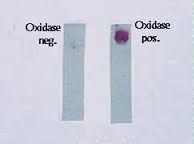
Oxidase Test |
Growth medium used: Loopful of nitrient agar. Reagents used: A few drops of oxidase reagent. Positive result or color: Purple Negative result or color: Clear |
|
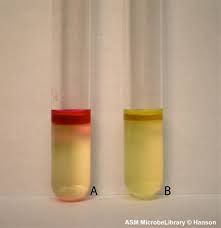
Indole Test |
Growth medium used: SIM Reagents used: 10 drops of Kovac's reagent. Positive result or color: Red Negative result or color: Yellow |
|

Methyl Red Test |
Growth medium used: Mr-Vp broth Reagents used: 5 drops of methyl red indicator (set aside aliquot for Voges-proskauer test) Positive results or color: Red Negative results or color: Clear
|
|
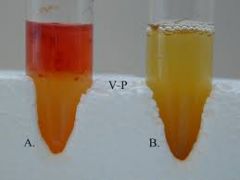
Voges-Proskauer Test |
Growth medium used: Mr-Vp broth (15 min incubation) Reagents used: Barritts reagents A & B Positive result or color: Red Negative result or color: Clear |
|
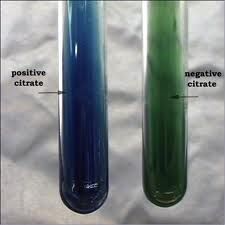
Citrate Utilization Test |
Growth medium used: Simmon's citrate agar Reagents used: None Positive result or color: Purssian blue Negative result or color: Green |
|
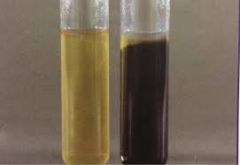
Hydrogen Sulfide Production
|
Reagents used: None Positive results or color: Black Negative results or color: Clear |
|
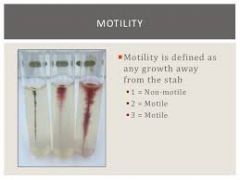
Motility Test
|
Reagents used: None Positive results or color: Cloudy throughout Negative results or color: Cloudy only at top |
|
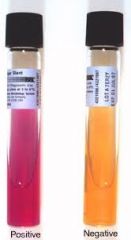
Urease Test
|
Reagents used: None Positive results or color: Hot pink Negative results or color: Light yellow |
|
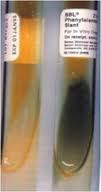
Phenylalanine Deamination Test
|
Reagents used: A few drops of 10% ferric chloride Positive results or color: Green at top Negative results or color: Agar stays clear |
|

Nitrate Reductase Test
|
Growth medium used: Nitrate broth Reagents used: 5 drops of A & B / Minute quanity of C Positive results or color: Red (after A & B) Negative results or color: Red (after reagent C) |
|
|
Given a plate of MSA, upon which a pure culture of bacteria has been allowed to incubate for 24 hours, determine: Whether the culture could be staphylococcus or not and explain why or why not.
|
*Staphylococcus* Because mannitol salt agar ferments gram positive staphylococcus bacteria. (Salt Loving) |
|
|
Given a plate of MSA, upon which a pure culture of bacteria has been allowed to incubate for 24 hours, determine: Which species (approximately) of Staphylococcus is represented, if it is a staph.
|
S. Aureus - Positive
S. Epi - Negative S. Sapro - Negative |
|
|
Given a plate of MSA, upon which a pure culture of bacteria has been allowed to incubate for 24 hours, determine: The full name of the (MSA) medium and describe it's primary ingredients.
|
(Mannitol salt agar) this medium contains a high salt concentration 7.5% NaCl which is inhibitory to the growth of most, but not all, bacteria other than the stapylococci. Enriches for gram positive! The indicator on the plate is phenol red.
|
|
|
Recognize and explain how the DNAse agar is used to reconfirm the identification of Staphylococcus Epidermidis and Staphylococcus Saprophyticus and describe how they differ.
|
Coagulase-positive staphylococci also produce the hydrolytic enzyme DNase; thus this test can be used to reconfirm the identification of S. aureus.
-S.aureus is positive has white surrounding/uses the DNAse. -S. sapro, S.epi are negative with blue surrounding. |
|
|
MSA
|
Yellow halo surrounding their growth = fermenting Staph will grow on the presence of catalase while the enteric will not.
|
|
|
DNAse AGar
|
-A rose pink halo around the area the area of growth
-Absence of halo is indicative of a negative result and the inability of the organism to produce DNAse. *OUR class had different agar! WHITE was POSITIVE. S. aureus. |
|
|
Identify the primary laboratory tests used to differentiate Staphylococcus Epidermis and Staphylococcus Saprophyticus and describe how they differ.
|
Novobiocin Test
|
|
|
Novobiocin Test
|
Is used to differentiate between the 3 staphs, the Mueller-Hinton agar plate is heavily seeded with the test organism to produce a confluent growth on the agar surface. (Kirby Bauer method is used.) -S. saprophyticus is the only resistant one-S. Aureus and S. Epidermidis are sensitive |
|
|
Coagulase Test
|
-Clot formation indicates a positive result
-The absence of coagulation is a negative result Production of coagulase is indicative of an S. aureus strain. The enzyme acts within host tissues to convert fibrinogen to fibrin. -Clot formation within 4 hours is interpreted as a positive result and indicative of a virulent S. aureus strain the absence of coagulation after 24 hours of incubation is a negative result, indicative of an avirulent strain. |
|
|
List the three genera of pyogenic cocci
|
1. Gonococci
2. Streptococci 3. Staphylococci |
|
|
Streptococcus pyogenes
|

Beta Hemolytic
|
|
|
Streptococcus pneumoniae
|

Alpha hemolytic
|
|
|
Staphylococcus aureus
|
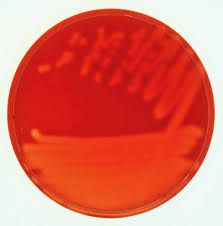
Beta hemolytic
|
|
|
Staphyococcus epidermidis
|
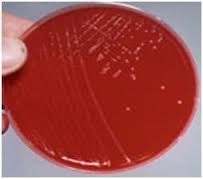
Gamma hemolytic
|
|
|
Identify (name) a quick & simple bio-chemical test to differentiate Streptococcus and Staphylococcus species.
|
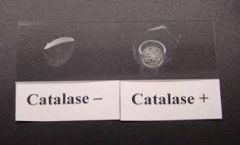
Catalase Test. If it bubbles it's staphylococcus positive
|
|
|
Identify (name) the small inverted tube used in the carbohydrate fermentation test state its function and how to interpret the results shows.
|
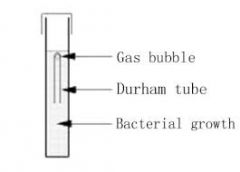
Durham tube
|
|
|
Identify at least one major clinical test used to differentiate Streptococcus pneumoniae from other alpha-hemolytic streptococci.
|
Optochin Sensitivity test.
|
|
|
Describe the use and application of the optochin ("p") or ("o") disk with streptococci and, provided with the name or a sample of optochin disks, identify the bacterial species that is used to differentiate from other streptococci.
|
Used to differentiate Streptococcus pneumonia from other streps. S. pneumonia shows zone's of inhibition (sensitive/dying)
|
|
|
Explain and recognize how to inoculate and interpret the results of TSI agar.
|
Triple Sugar Iron Agar! Is designed to differentiate among the different groups or genera of the Enterobacteriaceae, which are all gram-negative bacilli capable of fermenting glucose with the production of acid, and to distinguish the Enterobacteria from other gram-negative intestinal bacilli.The slant is inoculated by means of stab-and-streak procedure.
|
|
|
List at least four different genera of bacteria which are considered to be "Enteric bacilli" (Enterobacteriacaea) and describe at least two important characteristics they all share.
|
Citrobacter
Enterobacter Escherichia Klebsiella Proteus Pseudomonas |
|
|
Identify (name) each of the four bacteriological biochemical tests represented by the mneoric IMViC, and describe the significant of this battery of tests.
|
Indole, Methyl red, Voges-Proskauer, Citrate Utilization
|
|
|
NA
|
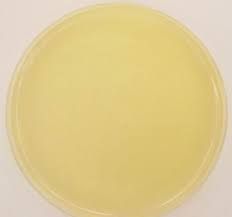
Nutrient Agar
|
|
|
BA or BAP
|
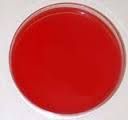
Blood agar or Blood agar plate
|
|
|
NB
|

Nutrient Broth
|
|
|
MR-VP
|
Methyl Red-Voges Proskauer
|
|
|
EMB
|
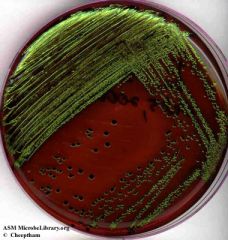
Eosin Methylene Blue
|
|
|
SIM
|
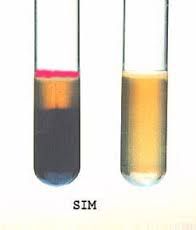
Sulfide Indole Motility
|
|
|
Identify the primary laboratory tests used to differentiate Staphylococcus epidermidis and Staphylococcus saprophyticus and describe how they differ.
|
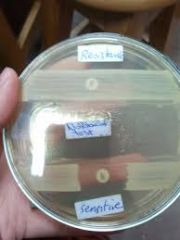
Novobiocin Test- Differentiates between the three staphs.
1. S. epi- Sensiitive 2. S. aureus- Sensitive 3. S. sapro- Resistant |
|
|
Identify the Lancefield's group that is associated with scarlet fever and strep throat.
|
Group A Strep
|
|
|
Identify (name) describe and interpret the results of the standard test used to determine if a beta hemolytic streptococcus belongs to Lancefield's group A. # 58 pg. 159
|
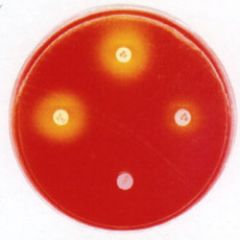
Bacitracin Sensitivity Test (A disk)
|
|
|
Identify the specific group of streptococci that are identified through the use of the bacitracin ("A") disk.
|
Group A strep / Streptococcus pyogenes
|
|
|
Identify (name) describe and interpret the results of the standard test used to determine if a beta-hemolytic streptococcus belongs to Lancefield's group A.
|
Bacitracin Sensitivity Test. Group A strep / Streptococcus pyogenes
|

